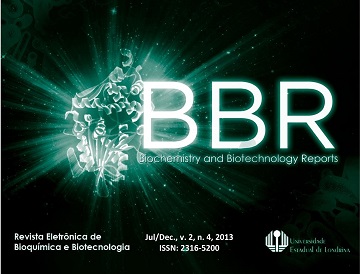Allelopathic potential of the ripe fruits of Solanum lycocarpum A. St. Hil. (Solanaceae)
DOI:
https://doi.org/10.5433/2316-5200.2013v2n4p37Palabras clave:
olanum lycocarpum, ripe fruits, allelopathic.Resumen
The species Solanum lycocarpum A. St. Hil., popularly known as the “fruit of the wolf”, is widely distributed in the Brazilian Cerrado. The fruits are usually consumed ‘in natura’ or used in jellies, jams or pasta preparations. The objective of this study was to evaluate the allelopathic potential of ethanol extract and fractions obtained from ripe fruits of S. lycocarpum against seeds of onion and lettuce. The ethanol extract and fractions showed allelopathic potential, especially on the growth of radicle of Allium cepa (onion). The dichloromethane and hydroethanol fractions showed inhibitory activity on the growth of hypocotyl of lettuce in concentrations at 125 and 250 µg/mL. The hydroethanol fraction inhibited growth of radicle of lettuce, at the three concentrations tested. At the concentration of 500 µg/mL, the dichloromethane fraction inhibited the radicle of lettuce in 86%. The ethanol extract and fractions showed inhibitory activity on hypocotyl of onion, in concentration at 500 ?g/mL, and radicle at the three concentrations tested. The dichloromethane fraction showed better allelopathic activity on the growth of lettuce and onion seeds. These results should encourage additional studies of extract and fractions from the ripe fruits of S. lycocarpum for the isolation of bioactive compounds with allelopathic potential.
Keywords: Solanum lycocarpum; ripe fruits; allelopathic.
communicaton / comunicação científica
The species Solanum lycocarpum A. St. Hil., popularly known as the “fruit of the wolf”, is widely distributed in the Brazilian Cerrado. The fruits are usually consumed ‘in natura’ or used in jellies, jams or pasta preparations. The objective of this study was to evaluate the allelopathic potential of ethanol extract and fractions obtained from ripe fruits of S. lycocarpum against seeds of onion and lettuce. The ethanol extract and fractions showed allelopathic potential, especially on the growth of radicle of Allium cepa (onion). The dichloromethane and hydroethanol fractions showed inhibitory activity on the growth of hypocotyl of lettuce in concentrations at 125 and 250 µg/mL. The hydroethanol fraction inhibited growth of radicle of lettuce, at the three concentrations tested. At the concentration of 500 µg/mL, the dichloromethane fraction inhibited the radicle of lettuce in 86%. The ethanol extract and fractions showed inhibitory activity on hypocotyl of onion, in concentration at 500 ?g/mL, and radicle at the three concentrations tested. The dichloromethane fraction showed better allelopathic activity on the growth of lettuce and onion seeds. These results should encourage additional studies of extract and fractions from the ripe fruits of S. lycocarpum for the isolation of bioactive compounds with allelopathic potential.

